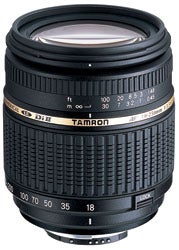Does this Tamron superzoom sacrifice quality in order to keep the overall cost down, or is it a bargain? The Tamron 18-250mm f/3.5-6.3 DI-ll (IF) LD Macro lens review from WDC reveals all.
Tamron 18-250mm f/3.5-6.3 DI-ll (IF) LD Macro Review
When it was launched, at Photokina in 2006, Tamron’s 18-250mm offered the widest zoom range of any DSLR lens, beating Tamron’s own previous world record of 18-200mm. Unsurprisingly, it went on to win the 2007 EISA award for Best Consumer Lens.
The layout of this lens has been copied by newer arrivals, with a broad zoom ring located closest to the camera body and a much narrower focusing ring beyond. The focusing ring rotates in AF mode but there is no movement of the lens barrel. The data sheet specifically warns against obstructing the focusing ring but, because of its foremost position, this can make the lens hard to hold steady at longer focal lengths.
Although a combination of low-dispersion glass and aspherical profiles is claimed by Tamron to give ‘sufficient compensation of aberrations’, the word ‘sufficient’ is rather ambiguous. A lack of edge sharpness was visible when the lens was used wide-open at its minimum focal-length setting and there was some visible image curvature, but these are probably not the aberrations to which Tamron was referring. Chromatic aberrations are particularly well controlled, for example.
Tamron proclaims the 18-250mm’s ‘macro’ capability boldly on the lens barrel, but its 0.29x maximum reproduction ratio falls a long way short of true macro photography. Perhaps it was noteworthy in 2006 but it is simply the norm today.
MTF testing suggests that the optics have been optimised for about 70mm and then have been extended by roughly equivalent factors to each side of this value. The shorter focal lengths perform almost as well as the 70mm sweet-spot except at wide apertures: the longer focal lengths are significantly weaker right across the aperture range. Real-world photography may not highlight these issues too severely, however.

Verdict
The 18-250mm’s compact size is likely to give it particular appeal for those who want an easy-to-carry all-purpose lens. However, in the middle of 2008 Tamron brought out an 18-270mm lens with in-built vibration compensation, which is an all-round better zoom (albeit a costlier one). This 18-250mm is simply a smaller, lighter and more affordable option.





